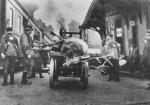![header=[Marker Text] body=[Formed April 18, 1843 from parts of McKean, Clearfield and Jefferson counties. Named for the large elk herd that roamed the area. First State Game Lands established in Pennsylvania, in 1920, are here. The county seat, Ridgway, was settled in 1824. ] sign](http://explorepahistory.com/kora/files/1/10/1-A-13F-139-ExplorePAHistory-a0a5h0-a_450.gif)
Mouse over for marker text
Name:
Elk County
Region:
Allegheny National Forest Region
County:
Elk
Marker Location:
County Courthouse, Main Street, Ridgway
Dedication Date:
July 22, 1982
Behind the Marker
Beaver Falls, Beavertown, Elk Lake, Elk City, Bear Creek, Honey Grove, Doe Run, Pigeon and Eagles Mere. All these are towns with names that memorialize the animals that once lived in Pennsylvania's forests. In 1843 when the lumbermen and settlers along the Clarion River carved out a new county from sections of Jefferson, Clearfield, and McKean, they named it "Elk," after one of the most magnificent animals of their ancient woods. At the time, the elk were fast disappearing from Pennsylvania's forests.
No animal in the forests of Pennsylvania was more impressive than Cervus elaphus, the Eastern elk. Larger than their western cousins, a full-grown bull could weigh 1,200 pounds, stand seventeen hands (sixty inches) tall at the shoulder, and carry a rack of antlers six feet in length. The eastern elk once roamed in large herds throughout Penn's woods, but their days were numbered. Farmers shot them to protect their crops, and Pennsylvania's deerslayers found them an irresistible trophy.
The Eastern elk were gone from the Blue Mountains by 1800 and from the Poconos by 1845. Elk were last seen in Lackawanna County less than a decade later. Caleb Mitchell shot the last elk in Mifflin County in 1857; James David made the last kill in Clearfield County in 1865. By the end of the Civil War, their range had been narrowed to the wilds of Elk and Cameron counties. On September 1, 1877, John C. Decker shot a young male in Centre County, and the Pennsylvania elk was gone forever.
was gone forever.
By the 1890s, animals no longer found in the state included the panther, wolf, Carolina parakeet, and passenger pigeon. Distressed by the disappearance of wildlife, Pennsylvania sportsmen successfully lobbied for the creation in 1895 of a
passenger pigeon. Distressed by the disappearance of wildlife, Pennsylvania sportsmen successfully lobbied for the creation in 1895 of a  state game commission to restore and protect wildlife. Over time, the Commission reintroduced deer, quail, wild turkey, and other game species. In 1913 the first shipment of western elk arrived by train from Yellowstone National Park in Wyoming and were released in Clinton and Clearfield counties.
state game commission to restore and protect wildlife. Over time, the Commission reintroduced deer, quail, wild turkey, and other game species. In 1913 the first shipment of western elk arrived by train from Yellowstone National Park in Wyoming and were released in Clinton and Clearfield counties.
The restoration of elk to Pennsylvania's woods went slowly. By 1923 the herd had grown large enough for the opening of a two-week hunting season. The Yellowstone elk, however, had a hard time adjusting to their new homes, so the game commission suspended hunting in 1930. In the 1960s there were still less than eighty, all living on in a small range in Cameron and Elk counties.
To help elk herds grow, the Game Commission increased openings in the forests to create browse--tender shoots, twigs, and leaves of trees and shrubs-- and planted alfalfa and clover in remote meadows to draw the elk away from farms. And the elk came back – along with deer, bear, wild turkey, grouse, and other wildlife. In 2001, by which time close to 600 elk again roamed the Allegheny highlands of northern Pennsylvania, the game commission again permitted a limited elk hunt. That year, some thirty licensed hunters harvested twenty-seven elk.
No animal in the forests of Pennsylvania was more impressive than Cervus elaphus, the Eastern elk. Larger than their western cousins, a full-grown bull could weigh 1,200 pounds, stand seventeen hands (sixty inches) tall at the shoulder, and carry a rack of antlers six feet in length. The eastern elk once roamed in large herds throughout Penn's woods, but their days were numbered. Farmers shot them to protect their crops, and Pennsylvania's deerslayers found them an irresistible trophy.
The Eastern elk were gone from the Blue Mountains by 1800 and from the Poconos by 1845. Elk were last seen in Lackawanna County less than a decade later. Caleb Mitchell shot the last elk in Mifflin County in 1857; James David made the last kill in Clearfield County in 1865. By the end of the Civil War, their range had been narrowed to the wilds of Elk and Cameron counties. On September 1, 1877, John C. Decker shot a young male in Centre County, and the Pennsylvania elk
By the 1890s, animals no longer found in the state included the panther, wolf, Carolina parakeet, and
The restoration of elk to Pennsylvania's woods went slowly. By 1923 the herd had grown large enough for the opening of a two-week hunting season. The Yellowstone elk, however, had a hard time adjusting to their new homes, so the game commission suspended hunting in 1930. In the 1960s there were still less than eighty, all living on in a small range in Cameron and Elk counties.
To help elk herds grow, the Game Commission increased openings in the forests to create browse--tender shoots, twigs, and leaves of trees and shrubs-- and planted alfalfa and clover in remote meadows to draw the elk away from farms. And the elk came back – along with deer, bear, wild turkey, grouse, and other wildlife. In 2001, by which time close to 600 elk again roamed the Allegheny highlands of northern Pennsylvania, the game commission again permitted a limited elk hunt. That year, some thirty licensed hunters harvested twenty-seven elk.






